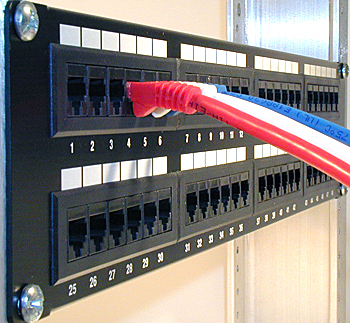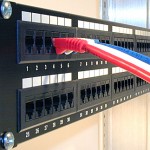
Office Network Installation: A Simplistic Overview
This drawing provides a simplified representation of the general topology of an office network installation. A "home run" design is commonly used in modern office network setups, where all cables are terminated at a patch panel. Depending on the size of the installation, the patch panel may be mounted on a rack or directly onto the wall. Regardless of the placement, every cable connects from the workstation's wallplates to the patch panel.
The image below showcases a more extensive patch panel connected to a switch, allowing network connectivity throughout the office.
Please click here if you require a cost estimate for your office network installation.
When networking between different floors in a building, a backbone or riser cable is often necessary; gathering essential information about the office structure is crucial before initiating a project. Is it a modern office building? Does it have hollow walls? Is there a drop ceiling present? If so, does the drop ceiling also serve as a plenum air return? Determining the number of total drops and how they are distributed to wallplates (single, double, triple, or quad drops) is essential for planning purposes.
Progressive Office is here to assist you if you require a quote for your LAN (data and voice) cable systems and support equipment installation. Our experienced team designs and installs network cable systems for PC networks and mainframe computer systems. We ensure that each installation meets or exceeds all city codes, state codes, and the manufacturer's specifications. To certify the compliance of new and existing cables, our technicians utilize the Fluke CableIQ Qualification Tester. We are dedicated to achieving 100% customer satisfaction and provide warranties for all our work.
Whether you are planning to relocate your existing voice or network cable system or install a new one, Progressive Office is prepared to guide you through the process and offer the most cost-effective solutions to bridge your office's information and communication gap.


 Your office
Your office 


 A
A